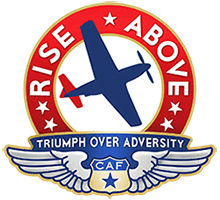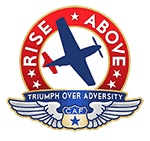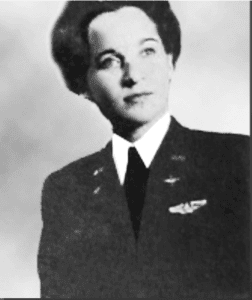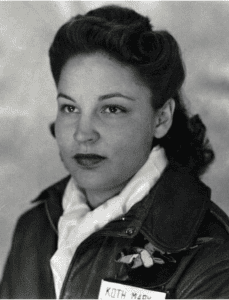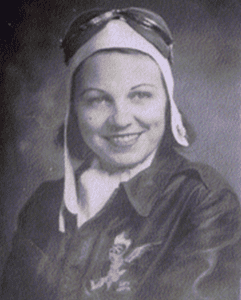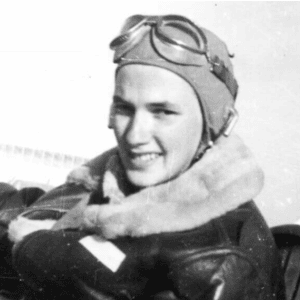 Lois Brooks Hailey
Lois Brooks Hailey
January 18, 1915 – April 24, 2010
Class: 43-W-3
Training Locations: Houston Municipal Airport (Tex.) and Avenger Field (Sweetwater, Tex.)
In addition to training in Houston, Jan-May of 1943, Sweetwater, May to July 4, Camp Davis, July to Oct, she also spent three months at Liberty Field from Oct to Dec before final assignment to Biggs Army Air Base with the 6th Tow Target Squadron.
Assigned Bases: Romulus Army Air Base (Mich.) and Camp Davis Army Air Field (N.C.)
Planes flown: A-24, A-25, AT-11, AT-17, B-34, BT-13, C-45, PQ-14, PQ-8
Lois was born on January 18, 1915, in the house she would grow up in at 331 Moran Street in Reno, NV. Her dad was Charles W. Brooks and her mother was Harriet Peckham. Lois had an older brother, Ernest, and four sisters; Ethel, the eldest, Myrtle, Carol, and Louise, who are all deceased.
Lois spent her youth as a tomboy. She also spent time at her Dad’s Model Dairy. She sold raffle tickets and won first prize, a horse. She learned early that her life was not bounded by others.
Lois attended Reno High and then went on to get a degree in Spanish and Education from the University of Nevada in Reno. During her senior year, she had to take care of her ailing mother, who was stricken with cancer. There was nothing Lois could do for her mother but try and comfort her. Lois did not know it at the time, but cancer would come into her life again.
After graduation in 1936 from U of N, Lois took a teaching job in Minden, Nevada, south of Reno. She directed the school band and gave private music lessons to interested students. She was also responsible for teaching photography for the school. Her plan was to save enough money to fulfill her dream of attending the Julliard School of Music.
All was going as planned, but outside influences were starting to detour her life. In June of 1939, Jim Peckham, a cousin, got her to join him and learn to fly. She fell in love with it. On December 3, 1939, mom flew solo for the first time. On January 17, she was awarded her solo license. By April 17, 1940, she had her private license.
On December 1, 1940, Jim and a friend, Vic Spezia, pooled their money, convinced mom to give up part of her Julliard savings, and they bought a single engine Taylorcraft, NC23875, for $1,995. Sharing the plane meant Jim and Vic got the plane during the week and Lois got it on the weekend. Lois also got to fly the plane over the mountains to take it in for maintenance work. Jim and Vic would kid mom by making up stories about the carburetor freezing or ice on the wings and the plane would fall out of the sky while she was in route.
After about a year of sharing the Taylorcraft, Jim and Vic sold mom their share in the plane. This was just as W.W.II was starting.
Mom, while still fulfilling her teaching duties, kept flying; spot landings, cross-country, chandelles, eights, verticals, spins, loops and stalls. Finally, on July 11, 1941, with over 300 hours, she took and passed her commercial license test to become the first female pilot in the state of Nevada to do so.
As the war progressed, flying was limited and fuel was rationed. On August 29, 1942, Lois, with just over 500 hours of flying time, sold her plane to a training school so it could be put to better use.
That didn’t keep her from flying though. In September of that year, her brother Ernest started his unsuccessful run for Congress. She borrowed a plane from a local gambler, Virgil Smith, to fly Ernest around northern Nevada.
This was also the time that Nancy Love and Jacqueline Cochran were putting their women’s flying groups together. Since Lois had over 500 hours, she received an invitation from Nancy Love to join the Women’s Auxiliary Ferrying Squadron (WAFS). All she had to do was travel back east for an interview with Nancy. She declined. Then she got a telegram from Jacqueline to meet her on the west coast for an interview.
Lois was interested in meeting Jacqueline, but not in joining the Army. So, she joined a friend, Iris Crtichell, who also got an invitation to join the Women’s Flying Training Detachment (WFTD) and they went to see what it was all about. Mom told them she wasn’t interested in joining and asked about Jacqueline. She was told that Jacqueline would not be there and that since she was there, she should take the physical just to see if she could pass. Well, she passed and ending up joining. Iris became part of the second class of the WFTD in Houston, Texas. Lois delayed her entry until after the end of the school semester and Christmas holidays. She joined the third WFTD class in January of 1943.
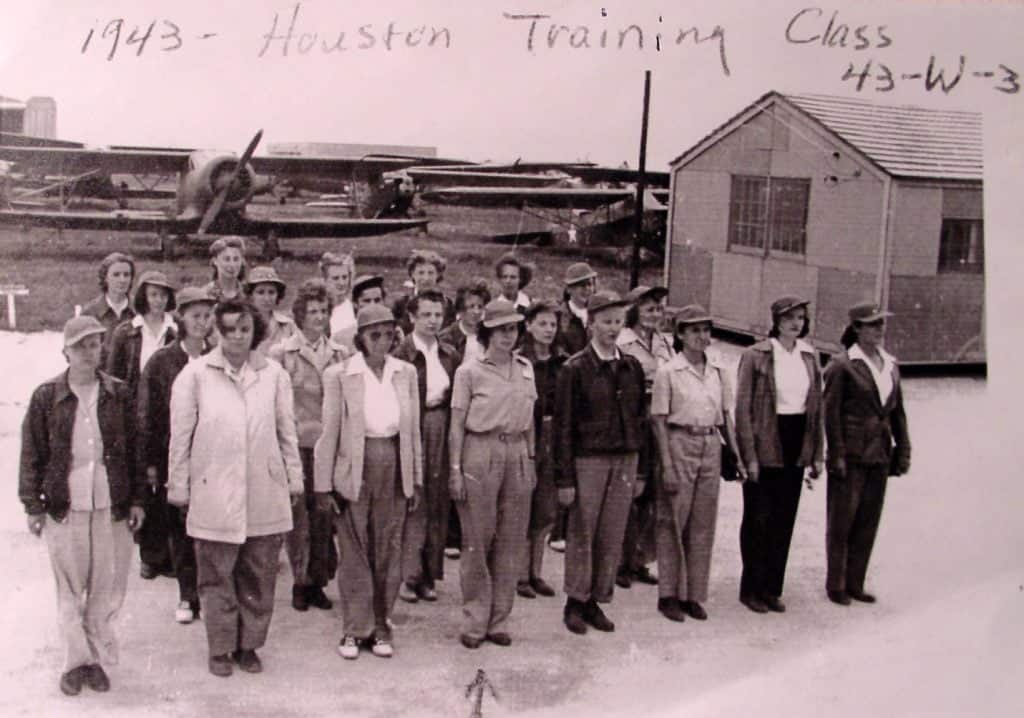
Lois Brooks and classmates, 43-3 at Houston Municipal Airport, 1942
After training for twelve months, including 6 months for tow target, she took on her next teaching job for the Army. While in the 6th Tow Target squadron at Biggs Army Air Field in El Paso, Texas, she helped the army personnel learn how to use machine guns and larger artillery to hit moving targets towed behind her plane. She also flew at night so they could learn to use search lights. She strafed infantry with tear gas. She was teaching young men skills that would either help them survive or help keep others alive.
In December of 1944, the WASP were disbanded. The jobs they were performing had to go back to the men that were returning from the war as it wound down.
As the end of the WASP drew near, Lois and her best friend, Lois ‘Holly’ Hollingsworth, started taking training to get their civilian instructor licenses. When they left the WASP, they joined Border Flying and started teaching GIs how to fly civilian aircraft as they left the Army.
By this time, Lois had accumulated over 1,300 hours of flying. For the next five years she and Holly supported themselves by teaching flying. They even pooled their earnings to buy a house.
In 1946, she also became the first chairperson of the El Paso Chapter of the 99s. In March of 1947, she soloed Sam Hailey, her husband to be and in June of that same year, she soloed her father Charles Brooks, age 65. At this point Lois had over 3,000 hours flying. During this time, she also wrote a column, “El Paso Air Lanes” for the El Paso Times.
Mom married Sam Hailey in 1947. In April of 1948, they became the parents of Charles Andrew. Her marriage didn’t last and she never remarried.
In the fall of 1949, she gave up teaching flying and went back to teaching band and orchestra with the El Paso School District. Mom’s teaching career in El Paso spanned 31 years and included earning her Masters in Education with a minor in Music from Texas Western College in 1953.
She typically taught at three different schools each day for a given school year and provided instruction at more than 10 different schools. At Austin High School, she taught a course in aeronautics, but most classes were band or orchestra. During that time, she continued to fly, but by 1978, mom had only added about 600 hours to her pilot log.
In 1980, three years after the WASP were finally recognized as veterans via an act of Congress, mom retired. During retirement, she continued to support flying through membership in the 99s and volunteering at the War Eagles Museum near El Paso. She also attended the WASP reunions that occurred every other year, including their last reunion in 2008. She also traveled to other activities honoring the WASP.
She was inducted into the El Paso Aviation Hall of Fame in 1985 and the Texas Aviation Hall of Fame in 2004. On the May 23, 2005, Lois was honored by the El Paso County Commissioners Court for her WASP service, her services to the El Paso ISD, and becoming the first chairperson of the El Paso chapter of the 99s. On March 10, 2010, she, and her fellow WASP were awarded the Congressional Gold Medal in Emancipation Hall of the new Congressional Visitors center in Washington, DC. for their service during WWII.
Lois is survived by her son, Charles “Andy” Hailey, his wife Mary and their daughter Dawn. Mary and Dawn were Lois’s caregivers since May of 2008 when Lois was moved from El Paso to Friendswood, Texas, to live with her immediate family.
Sources:
Obituary written by Charles Andy Hailey, son of Lois
For more about Lois visit: http://wwii-women-pilots.org/
Texas Women’s University in Denton, Texas
